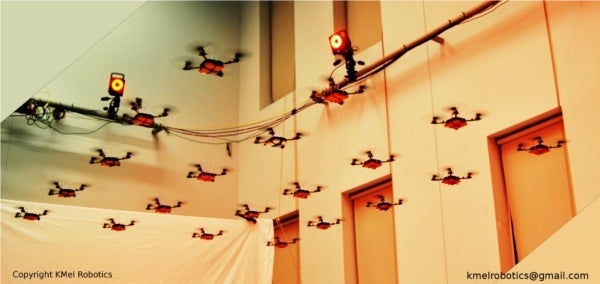Flying Robotic Swarm of Nano Quadrotors Gets Millions of Views, New Company

Share
These acrobatic robots can launch themselves through rings, duck and weave around obstacles, and even fly through your bedroom window. Hell, they can construct your bedroom window. Flying quadrotors first developed at UPenn's GRASP Lab by Daniel Mellinger have reached the big time. Their latest video, released last week on YouTube, has garnered nearly 3 million views! What's the big draw? Mellinger and his colleagues Prof. Vijay Kumar and Alex Kushleyev have created a swarm of 20 “nano quadrotors” - miniature versions of the stunt bots that can fly in complex 3D formations. The coordinated acrobatics of these quadrotors is truly amazing and exciting to behold (don't miss the video below). Not only have the quadrotor team out done themselves with this latest demonstration, they've apparently formed a new company, KMel Robotics around the devices. Could swarming flying bots be coming soon to a store near you?
Mellinger has been developing various versions of the quadrotor system at UPenn for several years. In previous demonstrations he and Vijay Kumar have shown larger incarnations of the quadrotors buzzing around at high speeds, revving up their engines to “leap” through obstacles, and dashing about like mad hornets. The swarm showcased in the video above adds the element of coordinated movement across a large number of the robots, up to 20, and in complex three dimensional formations. While the scale of these movements is really impressive (3 million views doesn't lie) it should be noted that the swarm relies upon external sensors for tracking position and movement. These robots aren't quite smart or aware enough to fly so smoothly entirely on their own. Vicon cameras (the boxes seen along the walls in the video) provide a central control computer with necessary data to help the robots keep from smacking into one another. Simpler instances of coordination were seen in earlier demonstrations when quadrotors worked together to build basic structures out of prefabricated beams. In that light this nano swarm should be seen as a natural progression of the technology rather than a quantum leap.
On a related note, previous demonstrations from Mellinger also revealed that the larger quadrotors were purchased form Ascending Technologies, not produced in-house at UPenn. While the latest video doesn't address this issue, the nano quadrotors bear a remarkable resemblance to AscTec's Hummingbird ResearchPilot drone. Undoubtedly Mellinger and his colleagues augmented the devices to work with their tracking and coordinating system, but the robots themselves may not be proprietary to the team.
Be Part of the Future
Sign up to receive top stories about groundbreaking technologies and visionary thinkers from SingularityHub.


Which raises some interesting questions about what the new startup, KMel Robotics, will focus on. The KMel site has almost no information beyond the statement that they are preparing to tell the world more (that's actually very understandable considering the enormous interest from the press and public the latest video has received). However, I will venture two guesses on the subject. First, while you can go to the AscTec site today and rent one of their quadrotors for aerial photography or acquire one for research, the capabilities developed by KMel are clearly above and beyond what the robot producer provides. That means KMel is likely going to focus on the networking/tracking/coordination side of swarm robotics, and that the quadrotors themselves may not be their actual product – just a test platform. Can you imagine similar feats of piloting performed with full scale military drones or surveillance UAVs? Definitely something worth forming a company around.
My second guess? Daniel Mellinger's online handle is “The Dmel”, which probably means that the 'K' in KMel Robotics is for Professor Vijay Kumar. Singularity Hub is glad to see that partnership continue, likewise with their impressive work on flying drones. Kudos to KMel for pushing the envelope; showing the world that modern robots have evolved beyond their awkward origins and can now move with the beauty of a perfectly synchronized ballet.
Image and video credits: kmel robotics
Related Articles

These Robots Are the Size of Single Cells and Cost Just a Penny Apiece

In Wild Experiment, Surgeon Uses Robot to Remove Blood Clot in Brain 4,000 Miles Away

A Squishy New Robotic ‘Eye’ Automatically Focuses Like Our Own
What we’re reading
